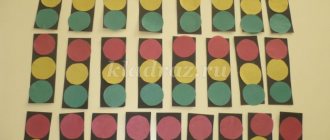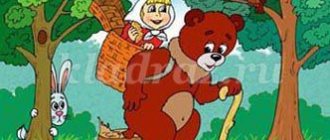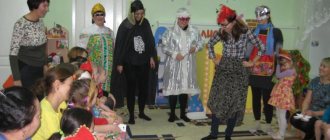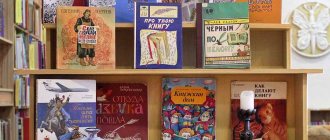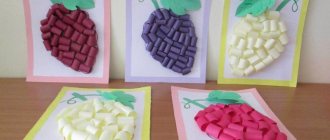Summary of GCD in the middle group. Vegetables
GCD summary.
Middle group on the topic: “Vegetables” Goal: To develop children’s interest in knowledge about vegetables through the integration of educational areas: cognition, communication, artistic creativity. Objectives: To form children’s ideas about vegetables, the place of germination and their preparation for the winter;
Strengthen children’s ability to describe vegetables according to their characteristic features, according to the diagram; Improve the ability to write grammatically correctly and consistently construct your statements; Expand the active vocabulary, activate the names of vegetables in children’s speech. Continue to develop in children the ability to distinguish and name colors, practice comparing objects by color; Encourage children to answer questions by pronouncing words clearly. To develop children’s ability to coordinate movements with text, understand and follow verbal instructions; Develop visual perception and memory, motor imagination and coordination of movements; Develop fine general and fine motor skills of the hands; Cultivate a friendly attitude towards peers; Create a favorable emotional atmosphere and conditions for active play activities of children. PROGRESS OF THE CLASS:
Vos: Guys, guests came to us today, let’s greet them. The group suddenly became lighter, and the guys had more fun. Because at that hour the guests visited us. We welcome you with joy and wish you good health. Feel at home, the place is ready for you, We invite you, sit down and rest from the road. And now let’s tell our guests in verse what we will do now: Our smart heads will think a lot cleverly, Our ears will listen, our mouths will speak clearly, Our hands will clap, our legs will stomp, Our backs will straighten, we all smile. Voss: Look guys, I have multi-colored balloons, I’ll give them to you now. Question: What color is your ball? (Children's answers) Voss: On your chairs there are mugs of the same color as the balls, let's play the game “Find your house.” On my command 1, 2, 3, run to your house. Questions: Why did you choose this house? (Because the ball is red and the circle is red, etc.) Voss: Well done guys, they all found their houses correctly, Tell me, what time of year is it now? (Autumn) Why do you think so? (Children's answers) Voss: Guys, autumn gives people many gifts, remember what she recently gave us? Children: A basket of autumn leaves. Vos: That's right, but we can admire the leaves, and autumn has gifts that we can enjoy. These are vegetables and fruits. They contain many vitamins that are necessary for us to grow healthy. Surprise moment: (Crying is heard) Voss-l: Children, hear, someone is crying, let's go and have a look. (A hare appears from behind the screen) Voss: Who are these guys? (Bunny) Voss: Ask why the bunny is crying? Bunny: How can I not cry? My mother sent me to buy vegetables, but I don’t know what vegetables are and where they grow. Voss: Don't cry, bunny, we will help you. Children, tell me where vegetables grow? (In the garden in the garden bed) Let's go to the garden with you: Our legs are walking along a level path. We jump through a puddle, jump through a hole, oh, tired, where have we ended up? Voss: Where have we come? (To the garden) How can you say in one word what grows in the garden? (Vegetables) What vegetables do you see here? (Children's answers) What do people do in the garden in the fall? (They are harvesting) Voss: That's right, but not all vegetables are harvested the same way; vegetables are dug up, cut down, pulled out and picked. Do you know what vegetables are collected and how? How will we collect potatoes? (Children's answers) Voss: Children, collect the harvest of vegetables in a basket. How many vegetables are there? (A lot) Voss: Let's talk about vegetables. And to make it easier for you, I have prepared this diagram (name, shape, color, how to assemble it). Voss: Well done, guys, now treat the bunny with vegetables. Vos: I suggest you rest a little: (finger gymnastics) There are a lot of beds in the garden, there are carrots and lettuce, there are cucumbers and peas, but aren’t potatoes bad? Our green garden will feed us for a whole year. Bunny: Guys, do you know how to plant vegetables? Teach me? Voss: I have prepared dough for you, from which we will make a bed. And then we plant what? (Carrots and potatoes) Voss: That's right, we will plant carrots, and we will bury potatoes. Roll the dough into a sausage - this will be the garden bed. Questions: What are you doing? (Bed) What will you plant? (Children's answers) What is your garden bed with? (With potatoes, with carrots) Recreational: After work, it’s time to relax: Logorhythmic exercise: We’ll go to our garden and pick vegetables there (they walk) There’s cabbage and onions (putting hands forward in turn) There’s beets and garlic We’ll take baskets ( Tilts) We will collect our harvest. Bunny: Oh, while you were doing a round dance, my brothers hid all the vegetables, help me find them. Voss: Guys, go to these plates and find all the vegetables. Questions: What vegetables are hidden in your plate? Voss: Let's return the vegetables to the bunny. Bunny: Thank you children, but tell me what needs to be done to have vegetables on the table all year round? Children: They must be stored. Voss: Let's pickle the vegetables. Look, I have two jars? What's different about the cans? (Lids) That's right, lids. What color are they? (Red and green) What vegetables will we salt in jars? (Tomatoes and cucumbers) Pickle tomatoes in a jar with a red lid, and pickle cucumbers in a jar with a green lid. Questions: In a jar, with what lid did we pickle the cucumbers? In the jar, with what lid did we pickle the tomatoes? Voss: Now let’s salt the cabbage. Finger gymnastics “Cabbage”. Voss: Look how much children know about vegetables and how to prepare them for the winter. Bunny: Thank you guys, you helped me a lot, I really liked your place, but it’s time for me to go home to my mother, goodbye. Voss: Guys, the bunny was in such a hurry that he forgot to say that he left some treats for you, help yourself to your health. Questions: What do you treat yourself to? (Children's answers) How to call treats in one word? (Vegetables) What is in vegetables? What are vitamins for? Voss: Guys, the bunny also gave you “Vegetables” coloring books. You can color them in a group, and in the evening show them to your parents and tell them what vegetables are and where they grow. If you want to color them, then let’s say goodbye to our guests and start drawing.
We recommend watching:
Summary of GCD in the middle group “Mushroom Glade” Summary of GCD. My city Zheleznogorsk Summary of GCD in the middle group with elements of experimentation Integrated GCD for speech development and artistic creativity in the middle group
Similar articles:
Lesson summary for the middle group: Safety at home
Summary of a lesson in kindergarten “Receiving guests.” Middle group
Lesson summary for the middle group on the topic: Properties of glass
Lesson in the middle group of kindergarten. Village courtyard
Summary of a lesson on cognitive development in the senior group. Rules of conduct in the circus
Summary of GCD on the topic “Vegetables” middle group
Summary of GCD on the topic “Vegetables” in the middle group
Target:
- introduce the name of vegetables and the place where they are grown;
Tasks:
- develop the ability to describe vegetables;
- consolidate knowledge about color, shape, size;
- develop children’s speech, thinking, attention, imagination and perception;
Demo material:
magnetic board, dummies of vegetables, cards with images of vegetables, Hedgehog, ball.
Preliminary work with children:
looking at vegetables, talking, guessing riddles, reading poems.
Progress:
Organizing time:
- Our smart heads will think a lot cleverly, Ears will listen, mouths will speak clearly, Hands will clap, legs will stomp, Backs will straighten, we will all smile.
Surprise moment: (Crying is heard) Teacher:
“Children, hear someone crying, let’s go and have a look.”
(A hare appears from behind the screen) Educator:
- Who are these guys?
(Bunny) Teacher:
- Ask why the bunny is crying?
Bunny:
- How can I not cry? My mother sent me to buy vegetables, but I don’t know what vegetables are and where they grow.
Educator:
- Don't cry, bunny, we will help you.
Children, tell me where vegetables grow? (In the garden in the garden bed)
Let's go to the garden with you: Our legs are walking along a level path, Jumping through a puddle, Jumping through a hole, Oh, we're tired, Where have we ended up?
Educator:
- Where have we come?
(To the garden)
- How can you say in one word what grows in the garden?
(Vegetables)
- What vegetables do you see here?
(Children's answers)
- What do people do in the garden in the fall?
(They are harvesting) Educator:
- That's right, but not all vegetables are harvested the same way, vegetables are dug up, cut down, pulled out and picked.
— Do you know what vegetables are collected and how? — How are we going to collect potatoes? (Children's answers) Educator:
- Children, collect the harvest of vegetables in a basket.
— How many vegetables are there? (A lot) Teacher:
- Well done, guys, now treat the bunny with vegetables.
Educator:
- I suggest you rest a little.
Finger gymnastics “ Vegetables”
1. The hostess came home from the market one day (“we walk” with our index and middle fingers on the table,
The hostess brought home from the market
(we bend our fingers)
: Cabbage, carrots, peas, parsley and beets.
Oh (clap your hands)
2. Here the vegetables started a dispute on the table (we clench into fists and unclench our fingers on both hands)
Who is better, tastier and more necessary on earth
(we bend our fingers):
Cabbage, carrots, peas, parsley and beets.
Oh (clap your hands)
3. Meanwhile, the hostess took the knife (with an open palm placed on the edge, we make cutting movements along the open palm of the other hand)
And with this knife I began to chop
(we bend my fingers):
Cabbage, carrots, peas, parsley and beets.
Oh (clap your hands)
4. Covered with a lid, in a stuffy pot (we cover the other hand, clenched into a fist, with an open palm - we change hands to the rhythm of the poem)
Boiled and boiled in boiling water
(bend your fingers):
Cabbage, carrots, peas, parsley and beets.
Ooh (clap your hands)
And the vegetable soup turned out to be quite good!
(we stroke our stomach with our palm)
Game “Riddles and Guessing”
- Our piglets grew up in the garden, sideways towards the sun, with crocheted tails. These piglets play hide and seek with us (cucumbers)
- Both green and thick A bush has grown in the garden bed, Dig a little, Under the bush... (potatoes)
— Green branches grow in the garden bed, and on them are beautiful children (tomatoes )
— A patch on a patch — Green patches. All day on your stomach, basking in the garden bed (cabbage)
- Sundress on sundress, Dress on dress. And when you start undressing, you’ll cry your fill (bow)
— How mysteries grew in our garden bed — A curious red nose has grown into the ground up to the top of its head. Only green heels (carrots)
- These are so round. Juicy and large, turn green in summer, turn red in autumn (tomato)
Educator:
- Now let's play a game
Game “Name it kindly” (with a ball)
Stand in a circle. I will throw you a ball and name a vegetable, you will call this vegetable affectionately and throw the ball back to me.
- Tomato - tomato; - carrot - carrot; - cucumber - cucumber; - pumpkin - pumpkin; - onion - onion; - beets - beets; - garlic - garlic; - potato - potato.
Result:
The teacher asks the children what new have they learned? How can all these items from the garden be called in one word?
Summary of an integrated lesson in the middle group “Vegetables from the garden”
Marina Pechenigovskaya
Summary of an integrated lesson in the middle group “Vegetables from the garden”
Summary of an integrated lesson in the middle group
on the topic “ Vegetables from the garden ”
Summary of an open lesson in the middle group “Zvezdochka”
.
Educator: Pechenigovskaya M. A.
Integration of educational areas: cognitive, speech development and artistic and aesthetic development (Application)
Continue to consolidate knowledge about vegetables through the integration of educational areas: cognitive development, speech and artistic-aesthetic development
- continue to teach children to classify and name vegetables ;
- generalize and consolidate knowledge about the place of growth (vegetable garden, garden bed )
;
-continue to teach how to describe an object.
- develop attention, perseverance, and observation in children;
- develop children's active speech.
- develop the ability to work in a team.
A flat garden, vegetables on a magnet , a basket with dummies of vegetables .
- memorizing a poem about vegetables ;
- looking at images of vegetables ;
- outdoor game “Garden round dance”
;


